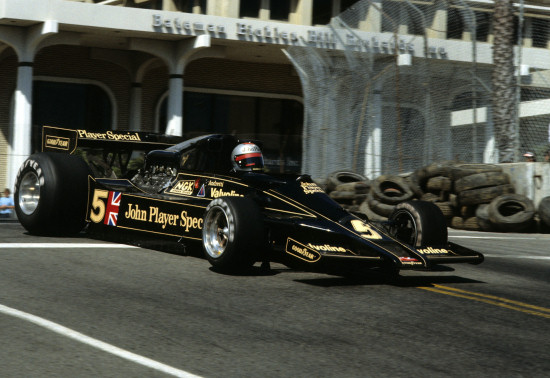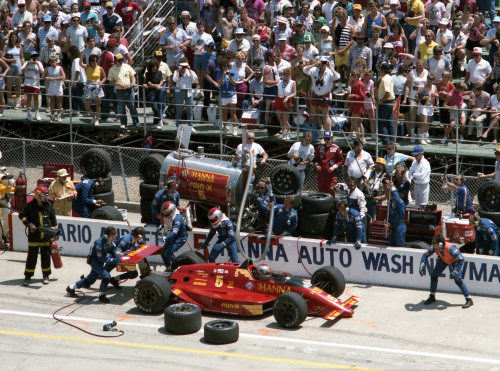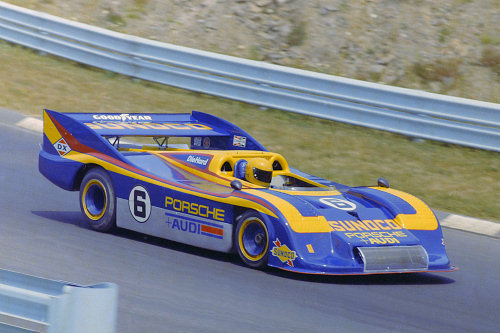The Way It Is/ What makes a great racing car?by Gordon Kirby |
 Last year Motor Sport published a special edition of the magazine called 'Great Racing Cars'. We surveyed more than 100 renowned drivers asking them to tell us about their favorite cars and they provided a fascinating list of over 200 Formula 1, Indy, long-distance sports car and rally cars.
Last year Motor Sport published a special edition of the magazine called 'Great Racing Cars'. We surveyed more than 100 renowned drivers asking them to tell us about their favorite cars and they provided a fascinating list of over 200 Formula 1, Indy, long-distance sports car and rally cars.
Over the next few weeks I'm going to post in this space the complete transcript of some of the great drivers and racers I spoke to for this project. I think it makes for entertaining and salubrious reading while providing some fine lessons for everyone in today's dumbed down, spec car infested world about what makes a great race car. We start this week with Mario Andretti, Dan Gurney, Rick Mears and Roger Penske. Andretti begins: "I had the pleasure of racing more than 160 cars over the forty years of my racing career and it's hard to narrow it down to one car," Mario says. "I was fortunate to drive competitively for four decades and when people ask me what was my favorite car my standard answer is the one that brought me a win that day!  © Racemaker/Jim Shane "In Formula One everyone expects me to pick the Lotus 79. But quite honestly, the Lotus 78 to me was much more fun to drive. The 79 had poor brakes. I won several races in the 79 with my brakes to the floor. When I clinched the championship at Monza with the 79 at the race where Ronnie died I actually won the race but Villeneuve and I were penalized for jumping the start. I spent the whole race chasing Villeneuve down and I had one clear outbraking chance on the last lap. When I did, the brakes on the 79 were so bad that my foot damn near went through the nose! "At Watkins Glen, the downhill section is fast and dangerous. In 1978 Carlos Reutemann had a slower car than me but he had the measure of me because his car had better brakes and I couldn't stay with him through there. So in many ways it was frustrating. "The reason the brakes weren't very good was because of the way Chapman designed them. Both the Lotus 78 and 79 had inboard rear brakes but they were detrimental to the airflow through the diffuser. So Colin decided to move the brakes further inboard on the 79. He had Hewland cast the gearbox containing half of the brake caliper which was therefore made out of magnesium. "Well, with a full load of fuel after four or five laps the brake pedal started getting longer and longer because the fluid was boiling in the calipers. You had some braking from the front but the rear would go to the floor. Pretty soon, there were no rear brakes. "We went through the whole season with both Ronnie and I screaming about the brakes. The problem was at the end of the race when they rolled the car onto the trailer they would ask the mechanics to check the brakes and once they had cooled down a little bit, the brakes were fine. So Chapman didn't believe us. He didn't like drivers telling him about technical things so he ignored us. We had battles over other things as well, but I'll always remember how bad the brakes were on that car.  © Racemaker/Paul Webb "In South Africa he pulled fuel out of the car just before the start and I ran out with two laps to go while I was leading. In Sweden the metering unit slipped to full rich and I was leading by 28 seconds when it ran out of fuel with two laps to go. That was before two-way radios and when I pulled in they had to scramble to get some fuel and put it in the car and I finished fifth or sixth. But I should have won that race. "At the end of the season at Mosport I had a one lap lead on Scheckter and I ran out of oil on the second-last lap at the top of the hill on the back straightaway. The engine scattered and Scheckter and a bunch of them went past me and I was classified ninth. So it should have been an easy championship win with the Lotus 78 but it wasn't to be. "I loved the 78. You could hustle that car right to the end of the race. When I won at Dijon I did a really hard outbraking on John Watson in the Brabham-Alfa. The 78 was great on the brakes. I outbraked Scheckter to win at Long Beach with that car. The 78 was a car I really enjoyed. "Then I go back through the sports cars I drove for Ferrari. I loved the 312P I raced with Jacky Ickx in 1971 and '72. You could throw it around like a Formula One car. It was small and nimble and we won a bunch of races in that car. I have great memories of driving that car. "We finished second in a nine-hour race at Kyalami in 1971 after going 23 laps down. I was on pole and led the first hour and then the fuel pump broke. By the time we got the car back to the pits and got it fixed we were 23 laps down and we came back to finish second. We made up I don't know how many laps. Jacky and I were going ten-tenths all the way. We had more fun then if we had led all the way. There were a few hours of rain which really helped us and after the race every corner on the car was bent because we leaned on so many cars as we lapped them. "Another sports car I really enjoyed was the Porsche 956. That was a very sincere car, a car you could push and push and it would always be under you. "In Indy cars, the car that really launched my career was the Brabham/Brawner Hawk that Clint Brawner built in 1965. We raced that car through 1967 and won two championships with it. In '66 and '67 I had two Indy 500s with that car that were the easiest of my career and should have won, but we didn't finish. That was a car I totally understood. I would decide what springs to run and we used to jack weight into the anti-roll bars with that car. We had some trick shit that really worked and I had a lot of fun racing that car.  © Racemaker/Paul Webb "There were also some dirt championship cars I loved. The one I really loved was the Ford V8-powered Parnelli dirt car from 1973 and '74. I felt really in command in that car. Al Unser and I were teammates in those cars and we traded wins back and forth. Al was really, really good on the dirt and we had some great races. Those cars had a lot of power but they were beautifully balanced and were really fun cars to drive. "Another car that really sparked my career was the Mataka Brothers' Kurtis-Offy midget I raced in 1962 and '63. I ran about fifty races with the Mataka brothers and won some races against some of the icons of east coast midget racing. That was a good car and it got me noticed and earned me a sprint car ride with Rufus Gray. And it was Rufus Gray who took me to USAC and told Clint Brawner in 1964 that I was the guy to hire. Rufus Gray's car was a very good sprint car and that car also really helped me on my way. "Another car from those days I really enjoyed was A.J. Watson's Ford-powered sprint car. I drove it only a few times but we won some races with that car. Watson really knew his stuff when it came to roadsters and sprint cars and we kicked butt with that car. "I remember these moments because those cars came along at the right time for me. They were pivotal times in my career that made a difference for me and propelled my career forward." Next is Dan Gurney, America's greatest racing man and founder of All American Racers and the legendary Eagle race cars. "My favorite car of all our Eagles was our 1981 Eagle-Chevy 'Boundary Layer Adhesion Technology' car," Dan says. "Mike Mosley scored a fantastic win in that car at Milwaukee, coming through the field from the back of the grid after blowing an engine in qualifying.  © Racemaker "But if you ask me to choose my favorite of all the cars I raced, I have to pick Frank Arciero's Lotus 19. The Lotus 19 represented a great leap forward. It was not a good car from the reliability standpoint but we drove it on tracks like Daytona that put a lot of extra stress on it and it never failed us. "The Lotus 19 was the proverbial giant killer. With a little 2.5 liter Coventry-Climax four cylinder engine with big Weber carburetors it could take on the V8 Chevies and Buicks that were being raced at the time and any of the more fancied Jaguars and Ferraris. It was just plain easier to drive and faster. "It was a truly remarkable car that emanated from Colin Chapman's mind. When I first saw it, I was shaken by how beautiful it looked, and when I drove it not long after that it was beautiful in that regard also. You're talking about a moment in time where something like that could occur and it did. I've driven other Lotuses and quite a few different cars but the Lotus 19 lived up to its billing. "Based on my own ability to predict what Chapman was going to produce I talked Frank Arciero into buying that car before ever seeing it. The Lotus 18 Formula One car was Chapman's first rear-engine F1 car. It was a fast car and from what Chapman told me about the Lotus 19 it was going to better than the 18 and much better looking too. "So my faith in Chapman's creative abilities enabled me to sell Frank on buying this new rear-engine sports/racer. Being Italian and a fan of Ferraris and Maseratis, Frank was skeptical about buying a rear-engine English car, but I was able to convince him. "In my first race with Frank's Lotus 19 at Riverside in October, 1960, I qualified on pole and drove it in a dozen races over the next two years. I won at Nassau in 1960 and '61 and at Daytona, Mosport and Laguna Seca in '62. That was a great car. Like I say, it handled beautifully and I loved racing that car." Four-time Indy 500 winner and six-time Indy pole winner Rick Mears has particularly warm feelings for three Penske Indy cars, the PC6, PC10 and PC17. "I drove a lot of good cars," Rick reflects. "The PC6 was my first Penske Indy car and I got my first Indy 500 win with that car in 1979. I always thought that was a beautiful car. It had a nice, sleek shape and was the last of the flat-bottom Indy cars before ground-effect took over. The PC6 just looked nice. It had great lines and was a nice, clean design.  © Bob Tronolone "The other one that comes to mind was Nigel Bennett's first Penske Indy car, the PC17 in 1988. It was such a nice-looking car. That car just looked right. It had the right lines, the right shape and the right aero. Nigel did a great job of bringing style to functionality. The packaging was done just right. It was very clean. It looked right and it was a great car, a beautiful-handling car. "That was a few years after I broke my feet and everybody was pointing to my feet as being a problem for me on road courses. But the first time we ran that car at Long Beach on a street circuit we had quick time in the first practice session. Some people asked, 'What are you doing different?' And I said, 'Nothing. It's because the car is working and doing what I'm asking of it.' I won my third Indy 500 with that car and my teammate Danny Sullivan won the championship in 1988. So without doubt, that was a great car. "Those are the three cars that jump out for me. I loved racing the desert and off-road cars that we started in. Those cars were just plain fun to drive, but so were those three Indy cars. Usually, it was what you last won in. It could be an ugly car, but if it was fast it very quickly became good-looking." Roger Penske completes this week's initial series of memories of favorite cars of some of the sport's greatest drivers and competitors. "I think my two favorite race cars are the Porsche 917/30 Can-Am car and Mercedes-powered 'Beast' Indy car we won the 1994 Indy 500 with," Roger begins. "The 917/30 was a derivative of the 917/10 and it was the first real turbocharged racing car that was developed to compete in the Can-Am. McLaren had dominated for a number of years with big V8s and Porsche made the commitment to go forward with a full aerodynamic race car with lots of downforce and to have a turbocharged engine that would produce over 1,200 horsepower. The driver had a control knob where he could add boost as he wished. "We went to Porsche's test center at Weissach in 1972 and at the time there were no buildings. They had just built the track and we ran the 917/10. I watched that car test for half a day and there was a tremendous amount of throttle lag. Porsche worked on that to steadily improve the lag with the evolution of turbos and waste gates and when we took the 917/30 to its first race at Mosport in 1973 we had a tremendously competitive piece of machinery and Donohue went on to dominate that year's Can-Am series. "We set a closed course world record with that car and Mark Donohue drove it to many victories and the Can-Am championship in 1973. The execution of that by Porsche and Donohue and our team was outstanding.  © Dan Boyd "We saw we could build our own engine to those rules and we worked on it very quietly for a year and surprised everyone when we rolled out the engine for the start of practice for the Indy 500. We sat on the pole and dominated the race with our cars and won with Al Jr. and that engine. That was a great day for our team and company and it established my relationship with Mercedes-Benz like the Porsche 917/30 had done with Porsche. "Following that our dealership business with Mercedes-Benz expanded worldwide and I sold the Detroit Diesel engine manufacturing business to Mercedes. So you have to say those two cars and engines were very significant in both my racing and business careers. "As a driver, the Zerex Special was a car we built and I raced against guys like Dan Gurney and Jack Brabham. That was pretty exciting. We built the Zerex Special from a wrecked Cooper Formula One car. It had a 2.7 liter Climax engine in it which was the engine Jack Brabham had used at the Indy 500 and I sat in the center of the vehicle. They made us move the seat to the side for the next year and we still won with that car. Then we sold the car to Bruce McLaren and he put an Oldsmobile engine in it and it became the start of McLaren Cars. "When I go back and think about what were the fun cars to drive, I remember my RSK Porsche because you could hang it out. And my Birdcage Maserati was also a wonderful car to drive. I remember having a great race at Elkhart Lake in that car. Then we moved to the Cooper Monaco, also a very nice car to drive. "I could also go back to my '57 fuel injected Corvette I took my SCCA driver's school in at Marlboro, Maryland. You have to say that was the start of my racing career." Next week we hear from Emerson Fittipaldi, Parnelli Jones, A.J. Foyt and Johnny Rutherford. |
|
Auto Racing ~ Gordon Kirby
Copyright ~ All Rights Reserved |
